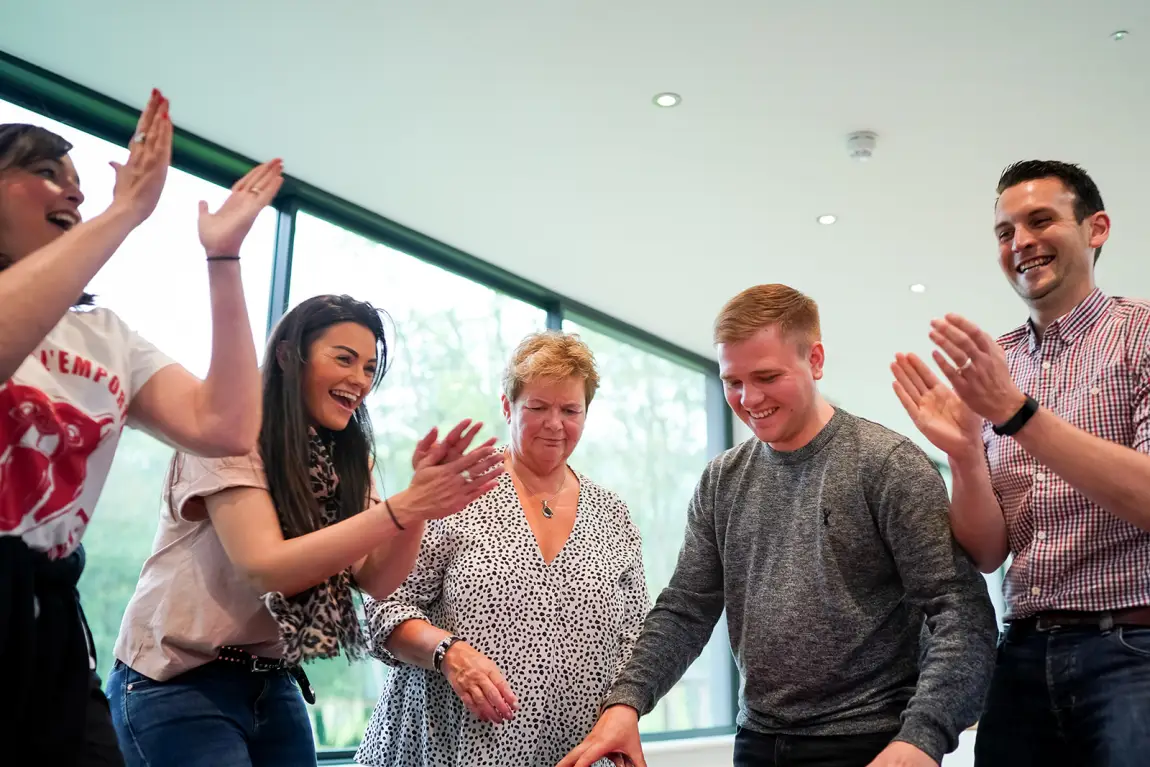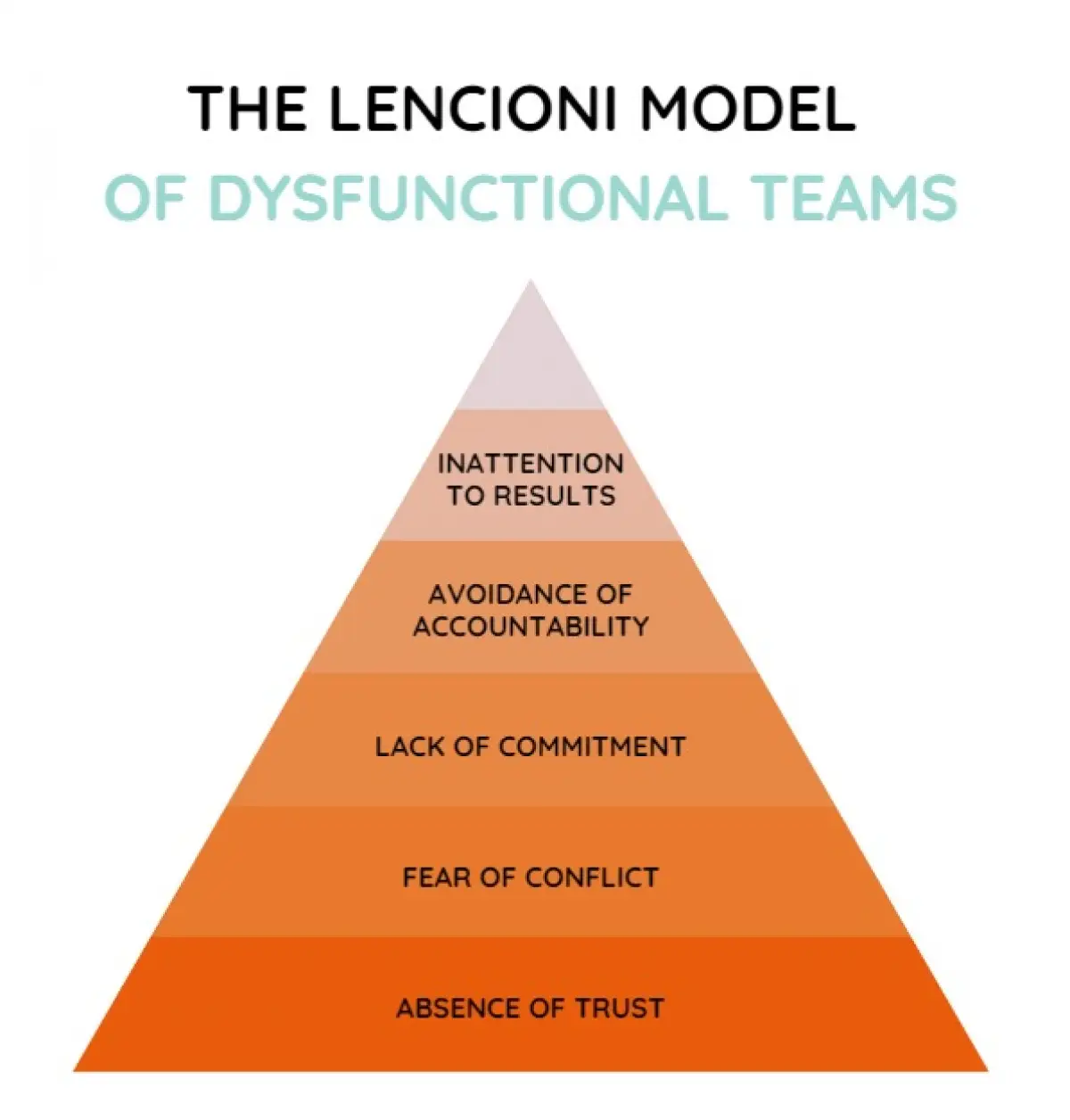
Building a successful team is more than just gathering talented individuals. It requires cohesion, trust, and effective communication. However, many teams struggle with common challenges that hinder their performance.
This is where the Lencioni model comes in - a framework developed by Patrick Lencioni that outlines five key dysfunctions that teams must overcome to achieve high performance and collaboration. We explain each of these dysfunctions, their impact on team dynamics, and how to overcome them effectively.
The Lencioni model offers a practical approach to diagnosing and resolving issues that undermine team effectiveness. These dysfunctions aren’t always isolated problems but are often interconnected, where one dysfunction fuels another.
Addressing these dysfunctions leads to stronger team cohesion and more effective outcomes.
According to Lencioni, the five dysfunctions are:
Understanding this model can help teams address specific issues and develop the right tools to generate unity and trust. The framework is widely used in leadership and team development because it provides clear and actionable insights that improve team performance.
The Lencioni model is structured like a pyramid, with the absence of trust forming the foundation.

Each dysfunction builds upon the previous one, which emphasises the importance of addressing these issues in sequence.
While your team might not exhibit every aspect of Lenconi’s model, it’s vital that you tackle each stage in order.
Teams that can overcome the lower levels of dysfunction are more likely to succeed in higher-level tasks, such as focusing on results and holding each other accountable.
At the root of many team issues is a lack of trust. In teams where trust is lacking, individuals hesitate to share vulnerabilities, whether that's admitting weaknesses, asking for help, or providing honest feedback. This reluctance stifles collaboration and growth, leading to a disconnected group where everyone is guarded.
Trust develops through openness and consistency. Team leaders should promote a culture of transparency and encourage individuals to share ideas and concerns without fear of judgement or ridicule.
Building this trust can be achieved through regular team-building activities, open communication, and a commitment to creating an environment where mistakes are seen as opportunities for learning.
Invest in your team-building. Go beyond awkward icebreakers and try collaborative problem-solving challenges that can bring a team together.
Empathy and understanding can be encouraged through ‘vulnerability sessions’ - time where team members can share personal stories or experiences that highlight their strengths and weaknesses.
Real-World Example: Google’s Project Aristotle
Google’s Project Aristotle discovered that teams with psychological safety, where members felt comfortable engaging in open discussions, performed better. This comfort with speaking freely led to innovative ideas and more effective problem-solving.
The second key dysfunction is the fear of conflict. Many teams struggle with this because individuals tend to avoid confrontation, fearing it will harm relationships or cause unnecessary tension. However, avoiding conflict only leads to unresolved issues, stifling innovation and delaying decisions.
Teams must understand that healthy disagreement can drive progress. Leaders should establish clear boundaries for debates, ensuring discussions remain constructive. Open dialogue creates room for creative problem-solving, allowing diverse perspectives to contribute to better decisions.
Real-World Example: Pixar Animation Studios
Pixar exemplifies an organisation that prioritises open dialogue as a driver of creativity. Their "brain trust" meetings encourage candid feedback without fear of judgement and without an imposition of hierarchy. This atmosphere of honest and open feedback has been essential to their consistent success in delivering high-quality animated films.
Teams without a clear vision often experience lack of commitment. When there is no firm decision-making or clear objectives, team members may become disengaged or indifferent. This leads to slow progress, with individuals not fully invested in the team's success.
To address this issue, clear objectives must be established, and decisions should be made with input from the entire team. Ensuring that all team members understand the goals, and how their efforts contribute to achieving them, helps increase engagement and commitment.
Example: Amazon’s Decision-Making Approach
Amazon uses the "Disagree and Commit" approach, where team members are encouraged to express their concerns or disagreements. However, once a decision is made, everyone is expected to fully support it. This method ensures alignment while maintaining efficient decision-making.
Teams that avoid accountability often experience lower performance. When individuals do not hold each other responsible for meeting expectations, it becomes easier for underperformance to go unchecked. This can derail a team’s progress and lower morale.
To ensure accountability, leaders must set clear expectations and establish regular check-ins to monitor progress. Holding team members accountable for their contributions, and encouraging peer accountability, helps maintain high standards and ensures the team is consistently working towards shared goals.
Case Study: John Lewis Partnership
John Lewis Partnership, known for its employee-owned business model, fosters a culture of accountability through shared ownership and responsibility. Each employee, known as a partner, has a stake in the business, and this structure encourages a collective commitment to the company's success. By promoting transparency and regular feedback, John Lewis ensures that every partner feels accountable for their role in the overall performance of the company.
The final dysfunction is inattention to results, which occurs when individual or departmental objectives take priority over collective outcomes. Without a focus on shared success, teams can become fragmented, with members prioritising personal achievement at the expense of group performance.
Leaders should emphasise the importance of team goals and align everyone’s efforts with the overall objectives. By regularly reviewing group performance and setting measurable team-wide targets, teams can stay focused on what matters most - results.
Real-World Example: Tesco
Tesco, one of the UK’s largest retailers, focuses heavily on collective success through its "Serving Britain’s Shoppers a Little Better Every Day" mission. Tesco encourages its employees to work together to meet customer needs and achieve overall business goals, rather than focusing on individual success. The company regularly reviews team and store performance, ensuring that the focus stays on group results and customer satisfaction, driving long-term success.
By addressing these dysfunctions through a systematic approach, teams can move toward greater efficiency, collaboration, and long-term success.
Whether your team is in danger of fragmenting, needs to build trust or simply deserve a reward that also benefits the business - book your next team building event now.
Can you afford not to?
1. What is the Lencioni framework?
This model, outlined in Patrick Lencioni’s book The Five Dysfunctions of a Team, identifies five common challenges that teams face and offers practical solutions for improving teamwork and performance.
2. How can teams build trust according to this model?
Teams can build trust by encouraging openness, fostering vulnerability, and creating an environment where members feel comfortable admitting weaknesses and asking for help.
3. Why is conflict important in teams?
Healthy conflict promotes innovation and helps teams address problems head-on. It encourages diverse perspectives and leads to better decision-making.
4. How can teams ensure accountability?
By setting clear roles, responsibilities, and regularly checking on progress, teams can ensure accountability. Encouraging peer-to-peer feedback also helps maintain high standards.
5. Can this model be applied to real-world teams?
Yes, companies like Pixar, Google, Amazon, and Tesco have successfully implemented principles from the framework to create high-performing, cohesive teams.

1st October, 2024
Psychological safety at work is a key factor for an organisation's success, employee well-being, and productivity. A psychologically safe workplace means employees feel…

2nd September, 2024
Meetings and conferences are both gatherings of people with a shared purpose - normally that of sharing or disseminating information. However, they serve distinct roles…

20th January, 2025
When attending a corporate event, how you present yourself matters more than you might think. Your attire, behavior, and interactions can shape how others perceive you a…